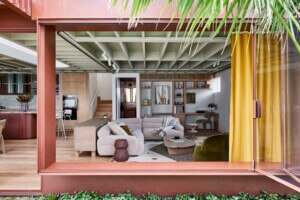In the United States, glass blocks began appearing in patents in the 1870s as part of vaults and skylights, but it wasn’t until 1881, when a patent was filed for “glass building block and building,” that a brick-like, hollow-core glass item arrived. Its inventor, C. W. McLean, speculated that the product would be ideal for the walls, partitions, and floors of hospitals and infirmaries. The rest is history. Glass block was regularly used in modernist buildings, but it met its full expression in postmodernist compositions, where its 8-inch–square format, often laid out in piano curves, seemed ubiquitous. Today, its usage invites a warm feeling of translucent history, as it thickens light into a cast, luminous form.
The material is put to impressive use in Outbuilding, with Deep Garden: a small project by Baracco+Wright Architects that adds a small back building behind a 1980s, concrete-block house designed by Ross Perrett in Melbourne, Australia. The architecture practice, led by Mauro Baracco and Louise Wright, often takes “on simple geometries and restrained material palettes that prioritize the spatial condition and rely on their relationship with landscape,” as the duo wrote on their website.
Read more on aninteriormag.com.











